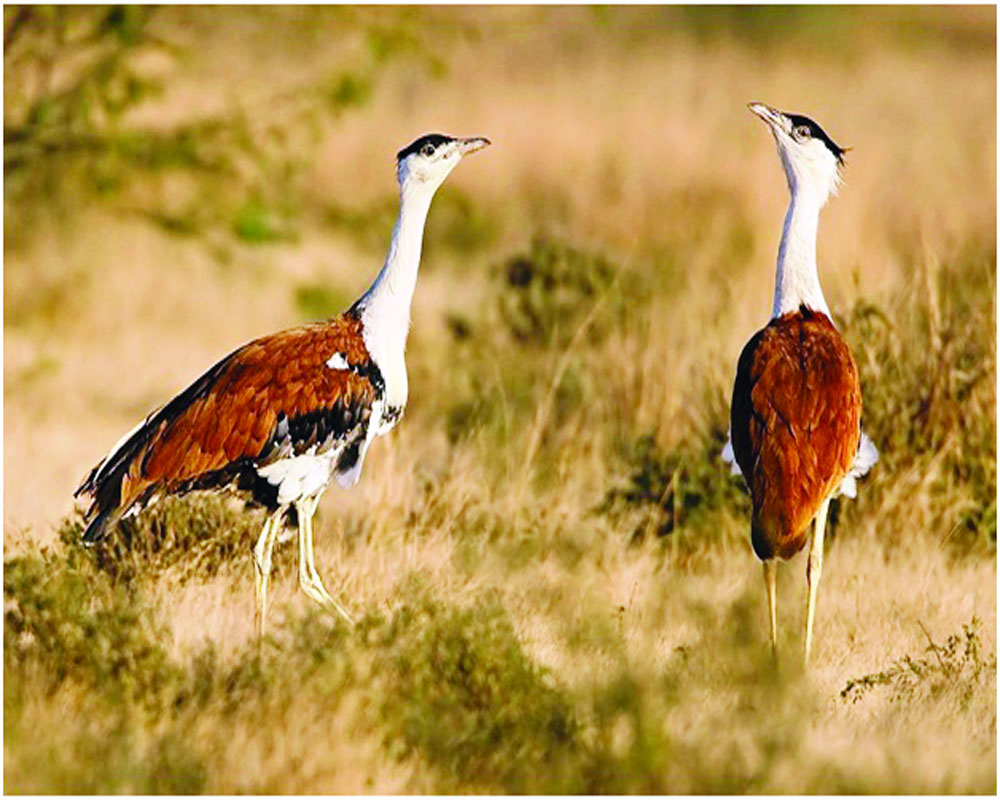The bird has been rescued from the brink of extinction. Yashna Shetty talks to the experts to understand how the mission is bringing about an improvement in their population as well as a change in mindsets
From far, it looks like an ordinary bird as it moves its spindly legs to roam around the grassland in search of a mate. But what makes this Great Indian Bustard (GIB) unusual is that this is the last male left in Gujarat. While some might despair at the news, others take heart at the birth of an artificially hatched chick in Jaisalmer, Rajasthan.
The GIB that lost the battle to be crowned the national bird of India is fighting another battle, this time around for survival. However, it is not alone as the decline in bird and animal species has been catastrophic as over the last 100 years more than 500 species have been lost instead of the nine that would have been expected at natural rates.
With less than 130 left in the country, the Centre has decided to step in and has initiated a project worth Rs 33.85 crore for their conservation and protection, according to the Environment Ministry.
India is spending Rs 100 crores over five years to bring four species back from the brink of extinction. They are the Great Indian Bustard, the Gangetic Dolphin, the Manipur Deer and the sea cow or Dugong. Almost a third of the money under the Species Recovery Programme is going towards the conservation of the GIB, the state bird of Rajasthan.
Arjun Awasthi, project associate of The Great Indian Bustard Conservation, Breeding and Habitat Project, Wildlife Institute of India says, “Power line collisions are the biggest issue. The power agencies need to install bird diverters. These devices make the power lines 70 per cent more visible to the birds and have reduced collisions in Europe and South Africa. Other threats to the bustard include loss of their grassland habitat, predation of their eggs by stray dogs and, in some parts, illegal hunting. My job, as someone who has worked closely with other species of bustards and other wild birds, is to facilitate the captive breeding of the birds and to ensure they have a safe, healthy and enriching environment to grow in.”
However, the Indian government is steadfastly developing a conservation-breeding programme to improve these numbers. “This involves radio tagging bustard females, figuring out their nesting sites, collecting eggs so that we have one chick in captivity and another in the wild and setting up a natural breeding population in a captive environment. All of this, with the hope to restore their natural habitat so that they can be released in the wild in the future,” adds Arjun, who has been working on this project for the last two years in Rajasthan. “The programme has seen success mainly in Jaisalmer. Our efforts are not only focussed on the ex-situ (captive breeding) component but there is also a significant push for the in-situ (on site; bustard habitat) conservation.” However, just captive breeding to push up the numbers is not the end of the process. Arjun highlights that “the first step in this whole process is completed but the ultimate goal is to release these birds into places where they can live, safely.” As always happens in any conservation programme, the attempt is to involve people and sensitise them, which is a long drawn process. The issue has also been highlighted at WWF.
Asad Rahmani, former director of Bombay Natural History Society and former chairman, Department of Wildlife Sciences says, “We shouldn’t be negative about the future of the GIB. The Wildlife Institute, Dehradun, has done a commendable job. For the last 30 to 40 years, things haven’t gone well and we are now left with very few birds but the first step of the conservation programme in Rajasthan has been successful. After breeding them in captivity, we would want to safely release them into the wild, in the future. We basically need to have a breeding stock.”
He goes on to add, “These birds cross the border and fly to Pakistan where they are hunted and people proudly post pictures of themselves with the bird as trophies on social media platforms.” Ask him whether people are aware about how serious the issue is, he says, “The need of the hour is sensitising the new generation to the concern as well.”
There is a larger issue involved as well which are related to how human beings are overtaking the planet and changing its demographics. Jai Dhar Gupta, environmentalist and founder of Nirvana Being, says, “Threats to most species are caused because of loss of habitat, which is due to land grab in the country. Even the insects that the bustard eats are poisonous because of the pesticides in them. All our environment-related issues are caused by greed. People like to grab every bit of land available and this is destroying our eco systems, completely.” A good example of this, he says, was people wanting to build a highway through the Aravali Hills, which he termed “crazy”. “Everything, from the air pollution to the loss of habitat in the country is harming our environment. The bustard almost becoming extinct, is a visible example of the harm being caused and we have literally reached a state of emergency” he concluded. The plan is to successfully complete the conservation programme for the GIB so it is out of the danger zone. While the process will take some time before we can see results, a more holistic approach to conserving all creatures big and small is needed rather than the belief of the survival of the fittest.


























